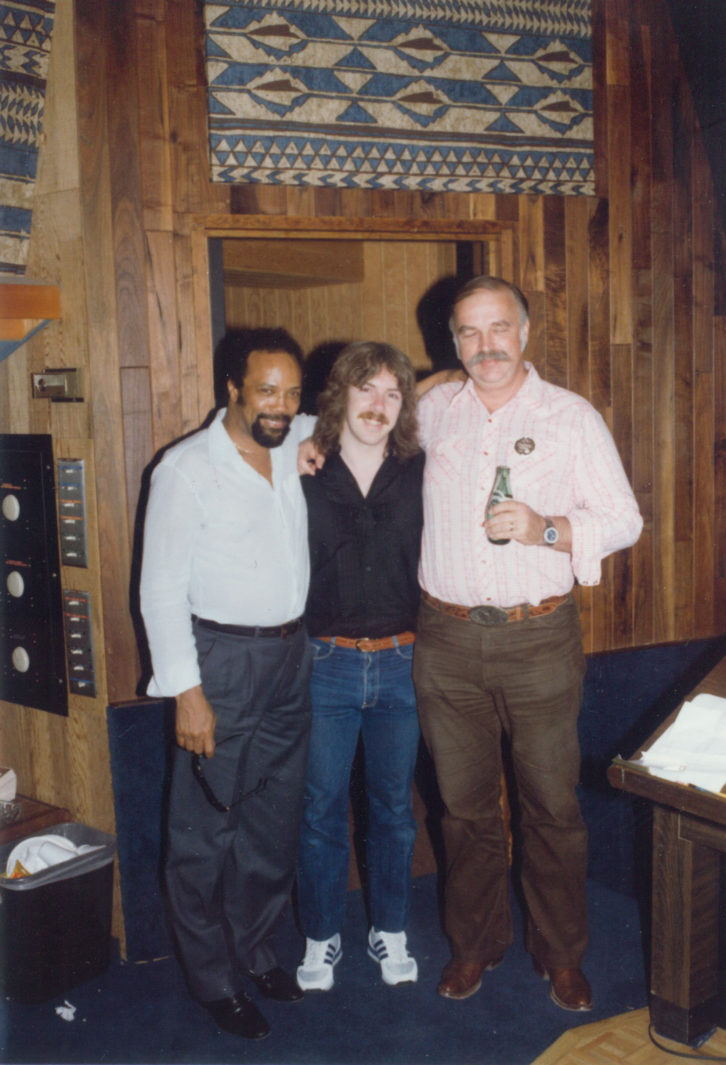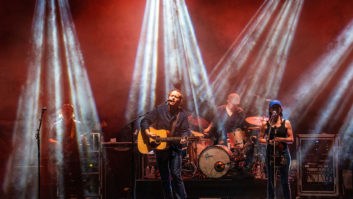
By Erik Zobler and Matt Forge
In the days following legendary engineer Bruce Swedien’s passing in late November, personal remembrances and tributes poured across social media. Erik Zobler, a longtime engineer and friend of the Mix family, called to say that he and another friend, Matt Forge, for many years Bruce’s assistant, were just reminiscing. We asked if we could listen in on their conversation.
Erik: You worked with Bruce for years. How did you land that gig?
Matt: Well, that’s actually a pretty good story. You and I were both employed at Westlake Studios. There was another engineer who worked there at the same time. He turned out to be quite a famous guy who, unfortunately, is no longer with us–Ed Cherney. There was a point when Ed was about to go independent. He came to me and said, “You know, Bruce and Quincy have a bunch of projects coming up and I think you’re the guy that would be best suited to step in to work with them.” I started with the Lena Horne Broadway show album, followed by Ernie Watts’s Chariots of Fire album, the Donna Summer album for Geffen Records. And then there was Michael Jackson’s Thriller.
 Erik: A little record called Thriller.
Erik: A little record called Thriller.
Matt: Yeah, it was it was a minor hit. [laughs]
Erik: Bruce is considered a recording God. You must have learned a ton from him.
Matt: The thing about Bruce’s sound was that he always did everything in the simplest fashion possible. He used an absolute minimum of outboard gear to record. The only thing he would regularly use was an 1176 on the vocal. And he used the 12:1 compression ratio. So it was actually a little bit more like a limiter than actual compression because Bruce did not like compression. Or at least not, shall we say, compression from electronic gear. He loved, and he was a master of, using tape compression as part of his sound. But if Bruce could have used a straight wire to go from the microphone to the 24-track, he would have. He used the dynamics from the performance of the musicians. When you have the top studio guys playing, they already know how to execute a performance. Bruce would get the blend of the instruments so that the musicians could hear themselves clearly. You know, in the studio, everybody’s separated, baffled and wearing headphones. It’s very different from a live performance. So Bruce would make that thing that was happening in their ears be very live, and very representative of what the musicians were trying to accomplish.
Erik: Did Bruce use any sound widening techniques or was it always a natural stereo space?
Matt: Bruce had a way of creating a sonic landscape by integrating different aspects of miking technique, along with how the microphone was used in an acoustic space. One of his favorite things to do was when he was recording backing vocals, he would record the first track and then a double of that track. And depending on how the harmony was structured, if there was going to be another track or layer, he would have the singer take several steps back from the microphone, and then for the next track, another several steps away from the microphone. He was using the element of early reflection to help reinforce the feeling of space. There was one recording in particular where his miking technique is, I think, outstanding. It’s a great example of the Blumlein technique.
Erik: Yeah, it’s basically x-y with the figure-eight.
Matt: Correct. The best example of that is on his recording of Michael Jackson’s “Man in the Mirror.” The André Crouch choir is standing in a circle, and in the center of that are a couple of 414s in a Blumlein configuration. I remember the day when Bruce played me a rough mix of “Man in the Mirror” in Westlake Studio D, and he cranked it up, loud. To this day. I’ve never had a moment like that in a studio where the hair just stands up on your arms and the back of your neck and you, you experience something like you have never heard before, right?
Erik: It’s one of my favorite Michael Jackson songs, especially for its sonics. Are there any other stories like that?
Matt: Sure. Bruce loved sounds that were generated acoustically. I remember the day that Michael came into the studio carrying a mailing tube with him. It was about four inches in diameter and three feet long with drawings on it. Michael said, “Oh, I sing a line through this,” and Bruce got excited. He asked me to put up a Shure 57, and that was how we recorded the little voice in “Billie Jean,” where there’s the “don’t think twice, do think twice” answer. So anytime anything could be done in an acoustic manner, Bruce referred to it as acoustic reinforcement. We would do other tricks like we would record percussion in the bathroom because it was a tiled room, and it had that really, really bright reflective sound. Studio A at Westlake had a mirrored room with marble floor and we would record something in there for that extra kind of kind of sparkle. He loved to put drums on a wood platform. Bruce wanted the sound reflecting off of natural wood. It gave that early reflection reinforcement, and made the sound have fullness. When Michael would sing vocals, especially for the Bad album, he would sing on the drum platform, and he would very often do dance moves. All of the sound from him moving, his shoes or snapping his fingers, those were all things that Michael was doing as part of the performance. That’s what Bruce was capturing. Bruce wanted to capture the entire performance for the sake of realism.

(PHOTO: Courtesy of Erik Zobler_
Erik: Did he add any other microphones, like lower to his feet, or was it just whatever made its way into the vocal microphone?
Matt: No, it would make its way into the vocal microphone because Bruce understood that adding a second microphone down by his feet would create some kind of phasing issue. So that wouldn’t fly. Bruce was always so aware of phase relationships.
Erik: You know, when you’re first starting out, you think getting a great recording is all about the gear. And it is important, but more important is the environment you set for the musicians to be able to do what they do, unimpeded, and express themselves creatively.
Matt: There was this thing that used to happen if you came into a session and it was a Bruce and Quincy date. First of all, you would be entering into an environment where here are a few guys enjoying themselves, having a great time. They’re great friends, it’s like you were you were coming into a little personal party that they were having with some great music. And I can’t tell you the number of times that people would come in—musicians to do an overdub—and there’d be this thing that would happen in the environment, there would be a conditioning aspect to the people coming in. Part of it was Bruce and part of it was Quincy. They were prepping them so that when they went out to give a performance, they were in a state of mind that was so conducive to artistic freedom and creativity. Quite a few times the performer would come in and Bruce would jokingly say, “Okay, let’s see if that recorded.” He’d hit Play and the sound that would fill the room was amazing. Bruce liked to listen loud, and he loved monitoring loud on the big speakers. The sound that he got out of those monitors, the low end was enveloping, and the way the energy was distributed through the frequency range was just so pleasing. It was a visceral experience because it was all-encompassing. And the performer would stand there and say, “Wow, I did that? I sound that good?” Bruce understood the value of wowing everybody in the control room.

(PHOTO: Courtesy of Matt Forge)
Erik: There were some things that Bruce said that I took to heart and I still say to this day. He would say, “Fill the meter, fill the speaker.”
Matt: Yes, because that’s where part of his sound comes from. He didn’t use a lot of compressors, but he did use the compression of the analog recording. If you’ve ever seen him do a mix and watch the meters on the 2-track, you know that he knew how much headroom was available electronically in the machine. And he knew how hard to hit the tape to get the sound that he wanted.
Erik: What about mixing? How did Bruce monitor?
Matt: When Bruce would mix, he would mix big and he would mix loud, and then he would mix on his favorite old set of JBL 4310s. But the other thing is, he would spend an enormous amount of time on the Auratones, really, really low. And he leaned in really close. And he would just focus on the details. And Quincy would always want to hear it there, too. Sometimes when we listened to the playback, Quincy would say, “Put it on the radio, Svensk,” Svensk being his nickname for Bruce. And then Quincy would lean, too. They knew the value to have something that related to the real world.
Erik: What was the best, if you can pick one, session you did with Bruce?
Matt: Well, it was on April 14, 1981, the tracking date for “The Girl Is Mine.” I knew we were doing an important tracking date. I did all my standard prep of mics and cables and stands and got all the gear ready. I was standing in the control room and I looked around. On the far side of the control room are the musicians from Toto along with Lewis Johnson. And at the producers desk is Quincy, and Bruce is at the console. Standing behind Quincy talking to the musicians is Paul McCartney. And next to him is George Martin. Geoff Emerick is behind Bruce. Michael Jackson is on the front side of the console. In the back there’s a few dignitaries from the music world. That was the “aha” moment of my life. I thought, “If I can’t learn anything about making great records, standing in the company of these people, then I’m never going to.”







